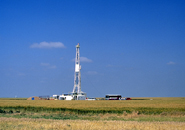Geological Survey drilling SW Kansas well to assess CO2 sequestration potential
LAWRENCE — A well being drilled in southwest Kansas is part of a study by the Kansas Geological Survey at the University of Kansas to determine whether carbon dioxide (CO2) from industrial sources can be safely injected deep underground for storage and to produce hard-to-reach oil.
The drilling location of the traditional vertical well is in northeast Stevens County about 25 miles northwest of Liberal.
CO2 is a natural and essential component of the atmosphere, but it is also a greenhouse gas — a byproduct of fossil fuel emissions from vehicles and such stationary sources as electric, cement, ethanol and fertilizer plants — that has been considered a cause of climate change.
Through a collaborative effort between the Kansas Geological Survey (KGS) and Berexco, a Wichita-based oil and gas exploration and production company, drilling of the 7,500-foot-deep well in the Cutter oil and gas field started August 1.
KGS geologists Lynn Watney and Jason Rush are lead investigators on the project. Berexco, Cimarex Energy, Elm II, Glori Oil, Merit Energy and Anadarko Petroleum are among the industry partners providing technical support and data. The well is being drilled solely for research purposes.
Easily recoverable oil and gas in the Cutter field and many other Kansas fields is in varying stages of depletion. Since 1961, 6.5 million barrels of oil and 13.5 billion cubic feet of gas have been produced in the Cutter field from the upper Morrowan-age sandstone of the Lower Pennsylvanian formation, about 5,200 feet below the surface.
Oil and gas has been produced for decades from the Morrowan as well as the underlying Mississippian Chester sandstone in nearby fields including Pleasant Prairie South, North Eubank and Shuck, which are also being studied in this project.
The KGS is investigating whether even more energy resources could be recovered safely and efficiently using CO2 and innovative techniques.
"Kansas still has hundreds of millions of barrels of oil that could be potentially produced using CO2 for enhanced recovery," Watney said. "If we find that large-scale CO2 injection is technically feasible, it could encourage partnerships between oil producers and businesses that emit CO2."
Noninvasive seismic imaging is already under way at the well site to map the properties of subsurface rock layers. Data collected from the well and the seismic study will be examined in conjunction with records from existing wells and more than 120 square miles of seismic data donated by industry partners.
While KGS researchers are assessing the use of CO2 for energy production, they are also studying whether the greenhouse gas can be permanently sequestered even deeper underground in the Arbuckle formation.
The Arbuckle is a porous rock group that contains saline water unfit for human consumption in this area of the state. Under the Cutter field the top of the Arbuckle is 6,750 feet below the surface and separated from shallower, freshwater aquifers by thousands of feet of impermeable rock.
"If the feasibility of safely using thick underlying saline formations such as the Arbuckle to sequester CO2 is demonstrated through this and other studies, the storage capacity could be substantial," Watney said. "Greatly increasing the sequestration capacity of the site would be an additional asset for companies operating the oil fields."
The project in Stevens County, designed to characterize the subsurface and model the movement of underground fluids, will not include injection of CO2. However, starting next summer 30,000 tons of CO2 will be injected into another well drilled south of Wichita in an earlier phase of the study.
In that operation, CO2 transported from the Abengoa Bioenergy Corporation's ethanol plant near Colwich will be injected to force out trapped oil from an approximately 3,600-foot-deep Mississippian dolomite reservoir in the nearly depleted Wellington field in Sumner County.
Enhanced oil recovery using CO2 has been used extensively in West Texas oil fields and in a demonstration project in Russell County, Kansas, funded by the Department of Energy.
The KGS will also submit an application to EPA for a permit that would allow an additional 40,000 tons of CO2 from Abengoa to be injected for long-term storage into the Arbuckle formation, whose top is about 5,000 feet beneath the surface at the Wellington field site.
That would be the first time CO2 emitted during industrial activities was captured and stored long-term underground in Kansas. Sequestration of CO2 in saline aquifers is being tested throughout the United States, with a larger test currently under way in Illinois.
The KGS-led three-year CO2 sequestration project has received nearly $21.5 million in cooperative agreement funding from DOE's National Energy Technology Laboratory, including a contract that has supported drilling and evaluation of the Cutter field well and two wells in the Wellington field.
The KGS and its industry and government partners during the project's several phases also provided millions of dollars in cost-share contributions, such as drilling and engineering personnel, equipment, facilities, discounted service, geochemical analysis, geologic modeling and computer simulation.
Other companies and university departments involved in the southwest Kansas project are the geology departments at KU and Kansas State University, Improved Hydrocarbon Recovery, Sunflower Energy, Bittersweet, Charter Consulting, Williams Petroleum Consulting, Hedke-Saenger Geoscience, Paragon Geophysical, FairfieldNodal, Halliburton, Weatherford Labs, Devilbiss coring, Trilobite Testing and Koger Remote Sensing.
Updates on the project's progress are available online.
